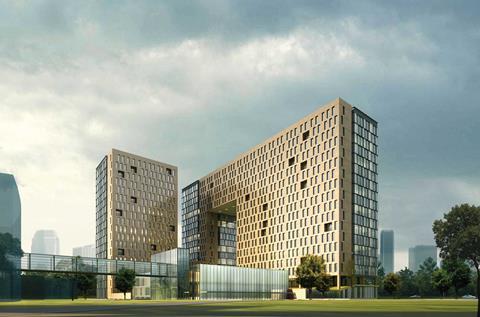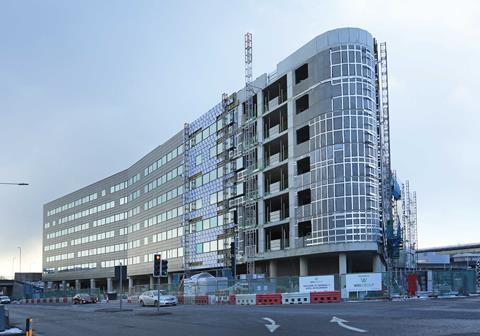In the light of recent industry discussions, this CPD, sponsored by Rockwool, will look at what the industry needs to understand in terms of a product’s combustibility rating and how clients, designers and contractors can achieve ‘lower-risk’ options in facades
CPD CREDITS: 60 MINUTES
DEADLINE: 5 OCTOBER 2018
For more information about Assemble Media Group’s CPD distance-learning programme, click here


INTRODUCTION
Over recent months there has been a widespread conversation about the fire performance, combustibility and non-combustibility of products, specifically around the substantive components that make up the facades of high-rise and high-risk buildings – these substantive components being recognised as both the cladding (decorative, weather-resistant material) and insulation.
This CPD will look at what the industry needs to understand about a product’s combustibility rating and how clients, designers and contractors can best achieve what is described in the Hackitt review as the “lower-risk” option in facades.
Defining the fire safety performance of materials
While stressing a duty of responsibility, Dame Judith Hackitt said: “In relation to the testing of cladding materials, there is currently a choice between using products of limited combustibility or undergoing a full system test. Using products which are non-combustible or of limited combustibility is undoubtedly the lower risk option.”
Approved Document B (ADB) provides guidance regarding fire safety measures required in buildings and the influence of those on the choice of materials used when constructing a building.
A prime example would be the choice of insulation to be incorporated into buildings over 18m high, for example apartment developments.

Section B4 of the Building Regulations requires the external walls of a building to “adequately resist the spread of fire”, with further practical guidance given in ADB. Specific guidance is given in ADB in relation to the cladding and insulation materials used on buildings above 18m tall.
At present, the potential ambiguity of ADB is the subject of much discussion – in particular, the guidance provided in section 12 relating to the fire resistance of external walls. However, there is clarity in respect of the fire safety of high-rise building facades, which is provided in section 12.5: “The external envelope of a building should not provide a medium for fire spread if it is likely to be a risk to health or safety. The use of combustible materials in the cladding system and extensive cavities may present such a risk in tall buildings.”
This guidance was echoed in the Department for Communities and Local Government – now the Ministry of Housing, Communities and Local Government – “Advice for Building Owners”, section 8, paragraph 3 (August 2017): “An obvious option to ensure that the cladding system adequately resists external fire spread, is to replace the system with one where all of the elements of the wall are of limited combustibility. For example, a wall system which includes an ACM panel with limited combustibility filler (category 1) and limited combustibility insulation such as stone wool.”
In order to understand this guidance, it is necessary to understand how the terms “non-combustible”, “limited combustibility” and “combustible” are defined.
| Euroclass | Definition | Example materials |
|---|---|---|
|
A1 |
Non-combustible |
Stone wool, glass wool, concrete, bricks |
|
A2 |
Limited combustibility |
Some A1 materials with organic facings |
|
B |
Combustible |
Some phenolic foams |
|
C |
Combustible |
Phenolic, some polyisocyanurate (PIR) |
|
D |
Combustible |
PIR |
|
E |
Combustible |
Flame-retarded expanded polystyrene (EPS)/extruded polystyrene (XPS), polyurethane (PUR) |
|
F |
Combustible |
PUR |
|
No performance determined (NPD) |
Combustible |
|
The Euroclass system
The Euroclass system is the harmonised European method of classifying the reaction to fire properties of construction products, providing a clear and simple method for comparing their performance when exposed to fire. Declaring a Euroclass rating is mandatory for all for CE-marked construction products.
To be classified according to the Euroclass system, products must undergo testing for a range of factors in accordance with BS EN 13501-1:2007+A1:2009: Fire classification of construction products and building elements, part 1 – classification using data from reaction to fire tests.
EN 13501-1 looks at results from the following “reaction to fire” (RtF) characteristics, covering:
- Ignitability
- Flame spread
- Heat release
- Smoke production
- Propensity for producing flaming droplets/particles.
However, a product’s toxicity is not assessed, only the amount of smoke produced.
The Euroclass system is accepted by all EU member states and is compulsory for products where there is a harmonised product standard. The rating system has seven classification levels: A1, A2, B, C, D, E and F, plus one rating “no performance determined” (NPD), that sits alongside but outside these ratings. Understanding these Euroclass classifications is vitally important.
ADB defines products achieving an A1 classification as non-combustible and products achieving an A2 classification as being of limited combustibility. A-class products – those classified A1 and A2 – make no significant contribution to fire growth. Products achieving a rating of B-F are are classified as combustible.
“Non-combustible” is a legally defined term within the UK regulatory system. Other terms typically used by the industry to describe product performance, such as fire-safe, fireproof, fire-retardant or flameproof do not necessarily define that the product is non-combustible.
If the insulation materials used on buildings taller than 18m are not “materials of limited combustibility or better” eg Euroclass A1 or A2, then the specified wall construction needs to meet the requirements of BR135: Fire performance of external insulation for walls of multistorey buildings. This requires the exact construction to be tested in accordance with BS 8414 part 1 or 2. The facade must be installed exactly as set out in the test.
However, expert witnesses to the Grenfell Tower inquiry and other fire experts have cast doubt on whether BS 8414 is a suitable means of determining the fire safety of cladding systems.
In contrast, using A1 and A2 cladding and insulation materials, often referred to as the “linear route”, is a straightforward method of complying with the Building Regulations’ requirements for buildings of more than 18m in height. It is a commonsense approach to fire safety which, when undertaken correctly, severely limits the opportunity for fire to spread across the face of a building.

How to find out a product’s reaction to fire characteristics
Manufacturers of CE-marked construction products in the UK are legally required to have their products independently tested to verify performance claims and declare a reaction to fire rating.
These results can be found in the product’s “declaration of performance” (DoP) certificate. Responsible manufacturers will make these declarations easily and readily available.
The DoP is a legal document in which the manufacturer identifies the product and its intended use, indicating compliance in relation to the relevant harmonised product standard and performance in relation to specified “essential characteristics”, including fire.
In the case of thermal insulation, all products should be CE-marked against the appropriate harmonised standard. The harmonised product standard for mineral wool is BS EN 13162:2012 +A1:2015.

The Hackitt review recommends that for new-builds, a building information modelling (BIM) approach should be phased in: “A BIM system will enable the dutyholder to ensure accuracy and quality of design and construction, which are crucial for building in safety up front.”
Clients, principal designers, principal contractors and building owners/landlords will each be required to fulfil the role of dutyholder (whether at individual or organisational level) and will each be assigned specific responsibilities at different phases of the building life cycle.
Each dutyholder will hand over to the next, maintaining what is known as the “golden thread”, which will ensure the building is procured, designed, constructed, operated and maintained in such a way that the key building safety requirements of the Building Regulations are sufficiently prioritised throughout.
BIM models can be used as a straightforward route for architects to identify not only the thermal and acoustic performance of insulation products but also their fire safety performance. BIM modelling allows for appropriate products and materials to then be incorporated into the design of the building. Responsible manufacturers will include the Euroclass ratings in BIM objects, and links should be available to the DoP.

What is a Class 0 rating?
Class 0 is a product performance classification defined in ADB, which is limited to assessing the “spread of flame” characteristics over the surface of a material derived when it is tested in accordance with BS 476 parts 6 and 7. The limited scope of a Class 0 rating is in marked contrast to the Euroclass system, which assesses combustibility (and, importantly, whether a material is non-combustible), ignitability, flame spread, calorific value and the development of smoke and burning droplets.
The fact that construction products achieving only the poorest Euroclass rating of F can be rated Class 0 also demonstrates what an ineffective measure this is. A Class 0 rating by itself should therefore not be taken as providing reassurance about a product’s fire performance, much less that it signifies that a product is non-combustible or a close equivalent.
Hackitt argued in her report that stakeholders needed to “begin thinking about buildings as a system, so that we can consider the different layers of protection that may be required to make [a particular] building safe”.
Our focus on safety should remain throughout the lifetime of a building. This would align with the use of BIM modelling for capturing product characteristics and specifying materials as identified above.
It also means that we should consider all materials used in the construction of a building, not just the facade. For example, on flat roofs, high-density roofing boards made from non-combustible stone wool (see box) can be used as part of a single-ply or high-performance built-up roofing system; high-density boards of materials can provide high levels of thermal and acoustic insulation. This type of product can be fixed directly to a metal roof deck.
In conclusion, everything should be done to encourage those involved in the design, construction and subsequent maintenance of a building to use non-combustible materials.
Stone wool insulation
Stone wool insulation has a Euroclass rating of A1, meaning it is non-combustible. It is manufactured from basalt, a volcanic rock. Stone wool insulation consists of layers of bonded, water-repellent-treated multidirectional stone-wool fibres formed into a resilient batt.
A key property of rock is that it does not burn. This means that stone wool insulation products can be used to create a firewall that slows down the spread of fire from room to room, improving safety and reducing the risk of property and asset damage.
It does not produce any significant toxic smoke and therefore also reduces the effects of smoke damage.

How to take this module
Assemble Media Group’s CPD distance-learning programme is open to anyone seeking to develop their knowledge and skills. Each module also offers members of professional institutions an opportunity to earn between 30 and 90 minutes of credits towards their annual CPD requirement.
This article is accredited by the CPD Certification Service. To earn CPD credits, read the article and then click the link below to complete your details and answer the questions. You will receive your results instantly, and if all the questions are correctly answered, you will be able to download your CPD certificate straight away.
CPD CREDITS: 60 MINUTES
DEADLINE: 5 OCTOBER 2018
Privacy policy
Information you supply to Assemble Media Group Limited may be used for publication and also to provide you with information about our products or services in the form of direct marketing by email, telephone, fax or post. Information may also be made available to third parties. Assemble Media Group Limited may send updates about Building CPD and other relevant Assemble Media Group Limited products and services. By providing your email address you consent to being contact by email, telephone, fax or post by Assemble Media Group Limited or other third parties. If at any time you no longer wish to receive anything from Assemble Media Group Limited or to have your data made available to third parties, contact the Data Protection Coordinator at building@building.co.uk. View our full privacy policy here.

















No comments yet